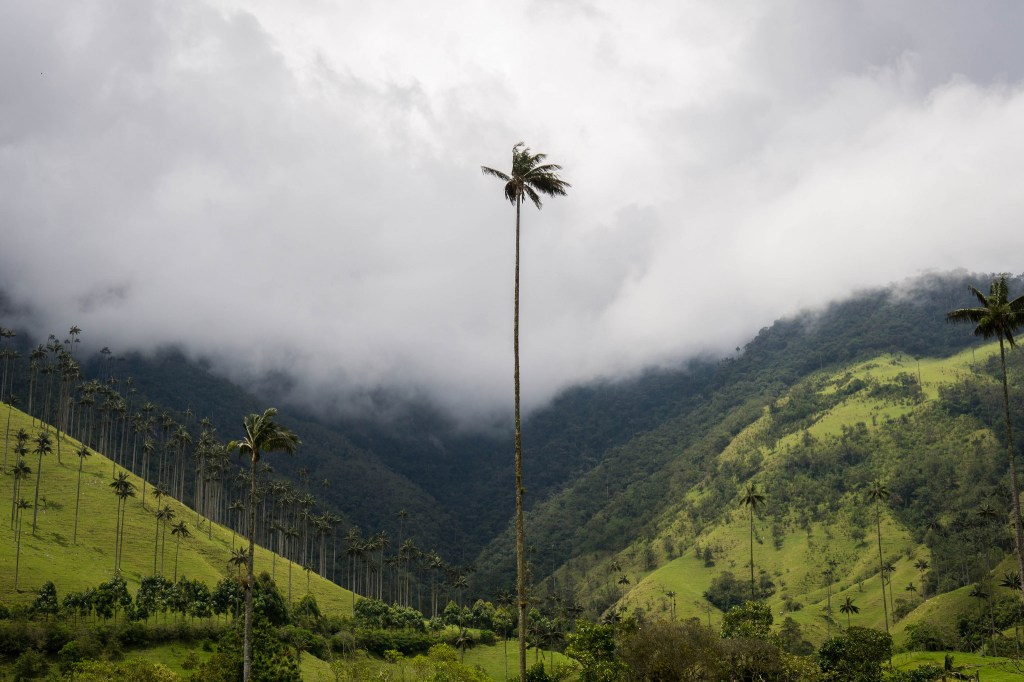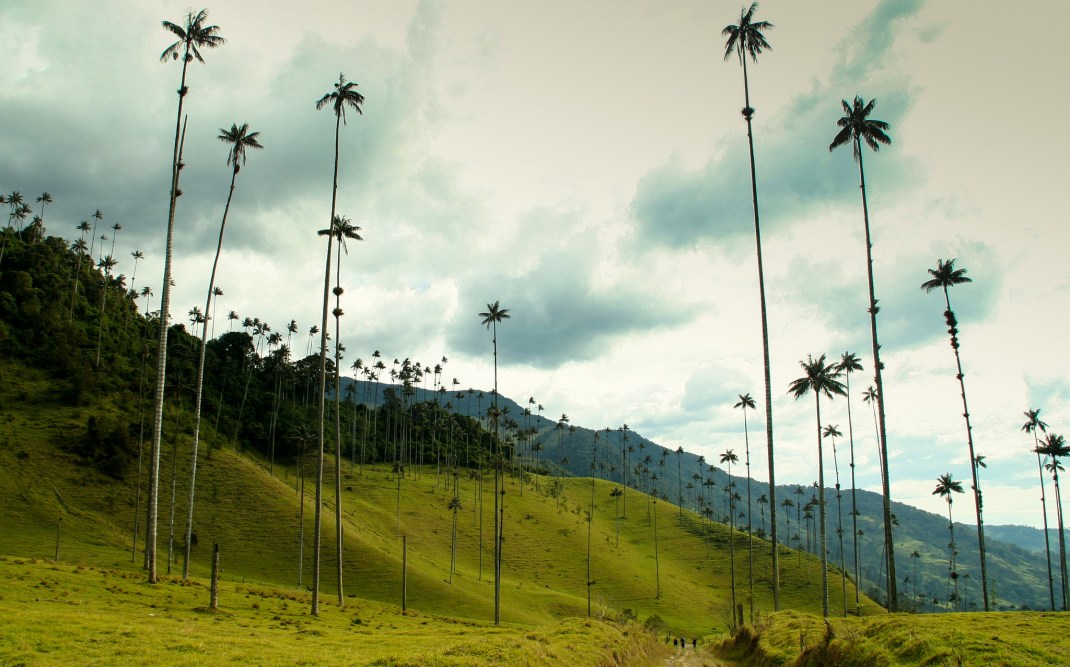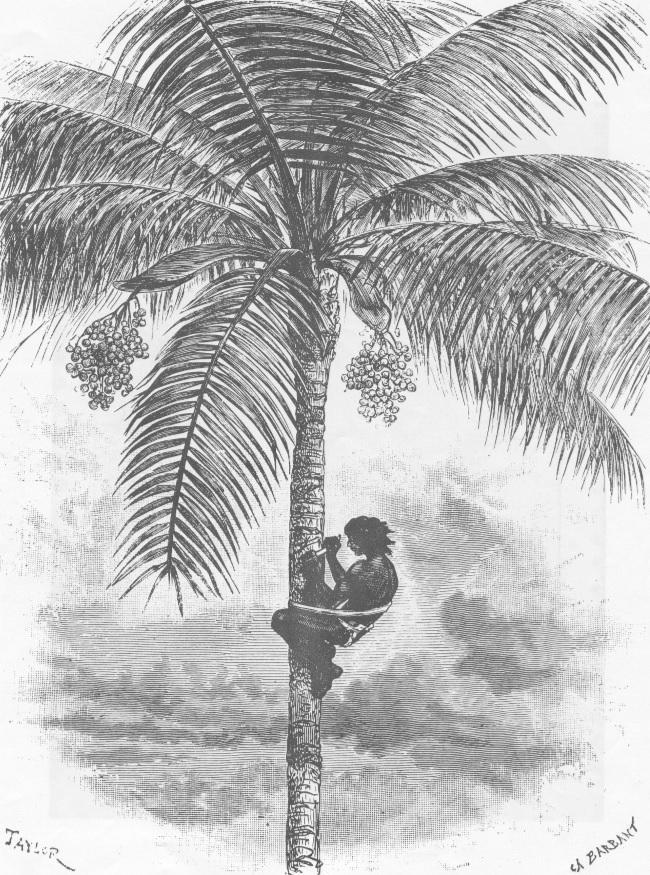Palm trees usually conjure up images of subtropical beaches, sipping cocktails through a straw stuck in a coconut shell. However, the Quindío wax palm makes its home high in the mountains of the Andes, and unlike any other palms can reach incredible heights of 60 m (200 feet) or more.
The ceroxylon quindiuense or wax palm is a species unique to Colombia’s Cocora Valley. It prefers wet, temperate climates and can’t stand temperatures above 20 C (70 f). This has made it notoriously difficult to cultivate outside of its native home, but fortunately it grows plentifully and is carefully protected as Colombia’s national tree (although palms are arguably not really trees).

Clouds cover a group of wax palms high in the mountains – photo credit Jonas Schleske
When it was first described by Spanish captain Bernardo de Vargas Machuca in 1599, it was noted only for the wax that covers its leaves. It wouldn’t be until the 18th century that botanists would study the palms in detail. A number of things immediately jumped out as unusual. Other than the thick wax it produced, researchers noted that it grew at altitudes of up to 2825 meters (9300 feet), more than 1000 m higher than any palm known at the time.
Another obvious feature is the tree’s height. Specimens were recorded at 68 m (200 feet), making them not only the tallest palm trees, but also the tallest trees known in the world at the time. It would be another 30 year before California’s great sequoias would break this record.

These palm trees can grow to heights of 68 meters (200 feet) – photo credit kzoop
When visiting the Cocora Valley in 1827, French Agronomist Jean-Baptiste-Joseph-Dieudonne Boussingault wrote this observation:
From this station, the view rests on a green horizon where the gigantic wax palm rises in numerous groups like white columns. From afar these parallel columns give the effect of masts of sail boats anchored in the harbor.

Wax palms in the Cocora Valley – photo credit kzoop
Wax trees had been known and used by indigenous peoples of Colombia for centuries. They were an integral part of their survival, with each part of the tree being utilized. Once felled the inner pith could be removed, leaving a remarkably durable shell which was used to build houses, fences, and stables. Their incredible length also made them useful for water pipes and channels, as well as more modern features like poles for power and telegraph lines.
Without felling the trees, the thick wax could also be carefully scraped off of the tree and leaves to produce torches and candles. This was the aspect that most interested western industrialists. Rather than climb the trees to harvest the wax, many were simply chopped down. Fortunately, limited supply made them unfavorable choices for production. Outside of candles, torches, and a few early gramophone records, the wax never found widespread use.
Western influence introduced a different kind of threat to the towering palms, this time cultural. A week before Easter, Christian residents removed the palm leaves to use in Palm Sunday celebrations. This holiday celebrates the arrival of Jesus in Jerusalem, with his followers behind him carrying palm leaves. Since mature wax palms grow to such incredible heights, the leaves were usually taken from younger trees, often killing them before they could begin reproducing.
Colombian botanist Professor Armando Dugand recognized this threat, and started pushing to make the palms Columbia’s national tree back in 1949. His efforts finally paid off in 1986, when the Colombian congress officially named ceroxylon quindiuense their national tree. This brought with it funds to buy the Cocora Valley to preserve its natural habitat. The decree also gave more resources to their study and conservation, and made it illegal to cut them down.
Today, the rainy Cocora Valley is a popular tourist destination. The natural habitat of the wax palms remains largely intact. And it must remain intact, because so far efforts to grow wax palms in other parts of the world have been largely unsuccessful. Cocora valley is the only place in the world where you can experience these magnificent giants.

These magnificent trees can only be found in Colombia – photo credit Alex Schwab
If you enjoyed this article about the Colombia’s wax palms, check out the archive for more tree stories. Also check out the Facebook page, with a few extra tree goodies throughout the week. Subscribe below to receive notifications whenever a new tree story is published.
As always, feel free to drop a comment below. It’s always nice to hear from you!
Further reading:


From the description, these trees seem to be similar to Bamboo plantations, both in their physical appearance and practical utility.
Nice story, by the way!👌
LikeLiked by 1 person
Absolutely! Palm trees are more closely related to bamboo and grass than the typical oak and beech trees that we all know and love. That’s why some don’t consider them to be trees at all!
LikeLiked by 1 person
Palmeras de cera, en Los Andes, qué curiosidad, no tenía ni idea!!
LikeLiked by 1 person
Beautiful photos. Really gives us a good perspective of the size of the trees.
LikeLiked by 1 person
Very inspiring to visit and read about. Well written and researched. I am a Canadian now living in Colombia, close to Cali. It will be on my short list to visit in the coming months.
LikeLiked by 1 person
Pingback: Cano Cristales Liquid Rainbow - Green Living Hive